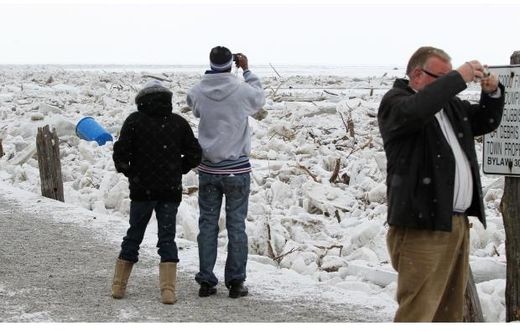
© Unknown
Major Thames River flooding is possible this spring because of a three-kilometre-long ice jam which remains in place at the river mouth.
"The potential for serious flooding exists -there is no question about it,'' Jerry Campbell, general manager of the Lower Thames Valley Conservation Authority, said Tuesday.
He said there is little, if anything, the authority can do other than closely monitor the river and report to municipal officials along the waterway.
Campbell said it's hoped the ice jam will slowly melt away in the coming weeks.
"What we fear is a warm spell accompanied by a heavy downpour of rain,'' he said. "That could spell disaster for residents in the Lighthouse Cove area as well as those upstream from Lake St. Clair.
Campbell said no contingency plans are in place to use dynamite to break up the ice jam or hire an ice breaker tug.
"We've tried both methods in the past with little or no success,'' he said. "Having the ice breaker on standby cost us $70,000.''
Campbell said shallow water in the river mouth prevents a large tug from entering the channel.
He said the only permanent solution would be a diversion channel from the river north to McFarlane Drain, which empties into Lake St. Clair.
"Our consultants recom-mended such a diversion channel in the late 1980s but the cost then was pegged at $5 to $6 million and no grants were available,'' he said.
Campbell said since the ice break-up in the river in early January, followed by heavy rains, the river has frozen over again with as much as 10 inches of ice.
The situation is com-pounded by the heavy snowfall received across southwestern Ontario in the last few weeks.
"A sudden warm-up, accompanied by heavy rainfall, would cause a real mess,'' he said.
Campbell said he plans to discuss the situation with Tom Bain, the mayor of Lakeshore.
Jim Cooke, owner of Lighthouse Inn at the mouth of the Thames River, is convinced the threat of serious flooding this spring is real.
"Doing something to deal with the problem is better than doing nothing at all,'' he said.
Cooke suggested having the Canadian Coast Guard break up ice in Lake St. Clair off the river mouth might be a step in the right direction.
"Our only safety net at this point is the low level of Lake St. Clair,'' he said.
Cooke said he's talked with a number of concerned residents in the Lighthouse Cove area.
He recalled that when dynamite was used years ago to clear the ice jam it killed huge numbers of fish and did little to free up the ice jam.
More than two dozen homes in the Lighthouse Cove area were surrounded by floodwater during the ice jamming in early January.
Glenn Archibald, who lives on the river upstream from Lighthouse Cove, had to use a boat to reach his home from the nearby roadway, built on higher ground.
Archibald said the ice jam hasn't moved since early January and remains about the same size it was then.
Jim Laevens, who also lives along the river in Dover, said the situation is in the hands of Mother Nature.
"But I can envision a very serious flooding situation in the coming weeks if we get a large amount of rainfall on top of warm temperatures,'' he said.
Bain, who is also warden of Essex County, said short-term and long-term action is required at Lighthouse Cove.
He plans to meet at the site of the ice jam next week with Essex MP Jeff Watson.
"I'm extremely concerned,'' he said. "And so are many residents in the area who have been calling me complaining that nothing is being done to clean up the mess.''
Bain said there is an urgent need to dredge the shallow river mouth leading into Lake St. Clair.
"There is a huge amount of junk in the river mouth ranging from tree limbs and trunks to wooden docks,'' he said.
Seems this is the Themes in Canada, not the UK.